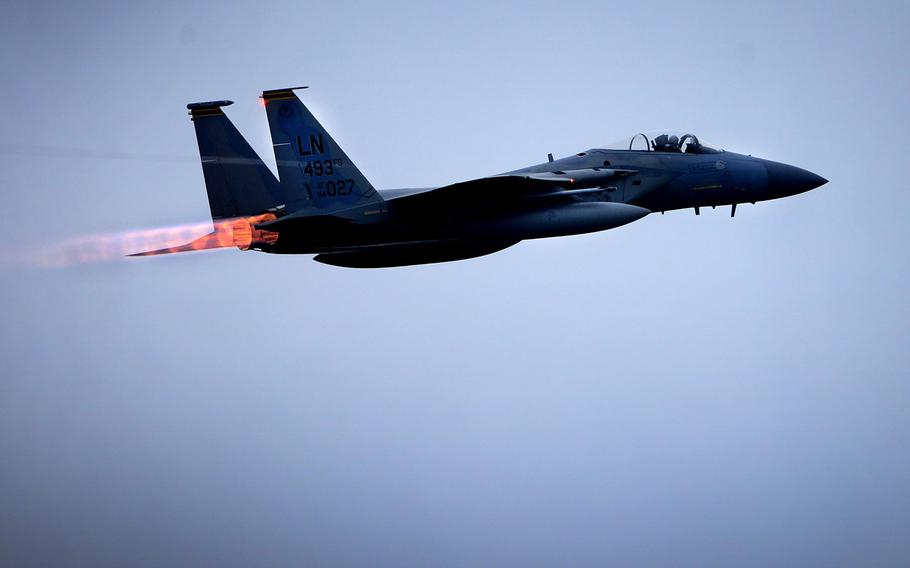
A U.S. Air Force F-15C Eagle aircraft assigned to the 493rd Expeditionary Fighter Squadron responds to an alert scramble notification at Siauliai Air Base, Lithuania, Sept. 4, 2017. ( Matthew Plew/U.S. Air Force)
The United States will hand over the lead in NATO’s Baltic air-policing mission to Denmark next week, concluding a four-month stay in Lithuania that saw U.S. fighter jets scramble about 30 times to identify Russian aircraft flying near NATO air space, officials said.
That number was comparable to past air-policing rotations, said Capt. Kay Nissen, U.S. Air Forces in Europe-Air Forces Africa spokeswoman. But, she said, there was increased activity in the beginning of the rotation because of a Russian military exercise at the time.
With the mission winding down, USAFE on Friday released video footage of “safe and standard” intercepts that occurred during the U.S.-led rotation. Part of the footage was captured from cameras mounted inside the cockpits of F-15s from RAF Lakenheath, England, Nissen said.
The clips show two intercepts — one on Nov. 23 and one on Dec. 13 — of two Russian Navy SU-30 Flankers flying in tight formation in international airspace near the Baltics. Russian jets frequently transit to and from air bases in the north to the isolated Russian enclave of Kaliningrad on the Baltic Sea.
The intercepted Flankers did not broadcast the appropriate codes required by air traffic control and had no flight plan on file, according to USAFE.
The U.S. rotation began in late August, just ahead of the Zapad 2017 exercise, a large six-day Russian war game that took place across the border from Lithuania, in Belarus and western Russia.
About 140 airmen and seven F-15C Eagles from the 493rd Expeditionary Fighter Squadron at RAF Lakenheath deployed to Siauliai Air Base, representing one of the largest air-policing contingents in the mission’s history; countries typically deploy four jets for a rotation. In November, the squadron scaled back to four deployed aircraft, Nissen said.
Since 2004, 17 NATO countries have participated in policing the airspace over Estonia, Latvia and Lithuania, which don’t possess fighter jets. The U.S. Air Force has led five rotations.
The mission involves safeguarding the airspace over the Baltic nations for about 120 days. NATO requires at least two aircraft to be on standby around the clock for the duration of the rotation.
NATO jets typically scramble whenever aircraft operate in an unusual, unsafe or unidentified manner near allies’ airspace. The intercept takes place over international airspace, Nissen said, and may be in response to an aircraft that’s not using its transponder, is not in radio contact with civilian air traffic control or has not filed a flight plan.
Nissen said the Lakenheath jets scrambled about 30 times to identify aircraft that did not follow international flight regulations and approached Baltic airspace. All aircraft intercepted were from Russia, she said.
All intercepts, she said, were “safe and standard,” meaning they were in accordance with International Civil Aviation Organization guidelines.
Lakenheath pilots also completed more than 560 flight hours and 270 training sorties during the four-month deployment.
svan.jennifer@stripes.com Twitter: @stripesktown